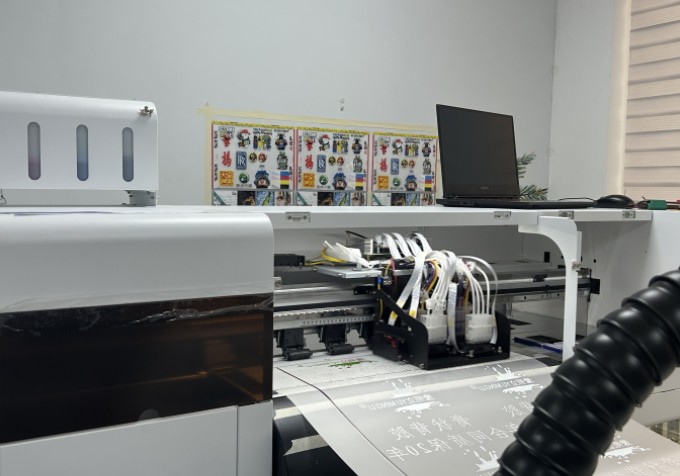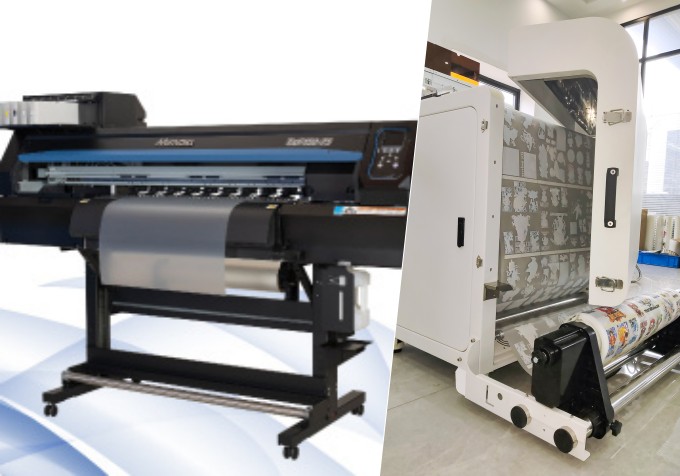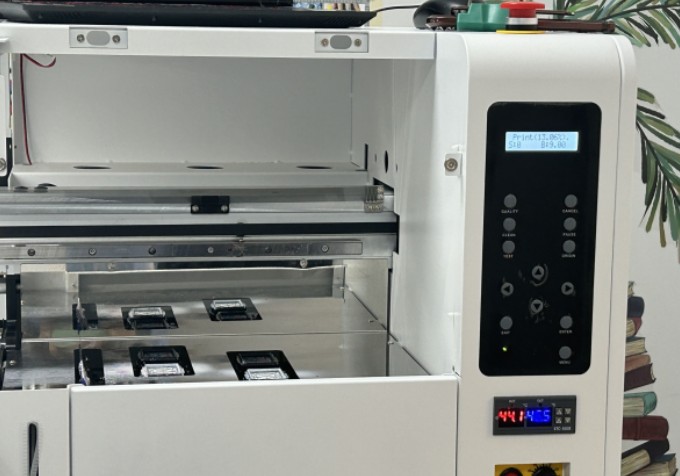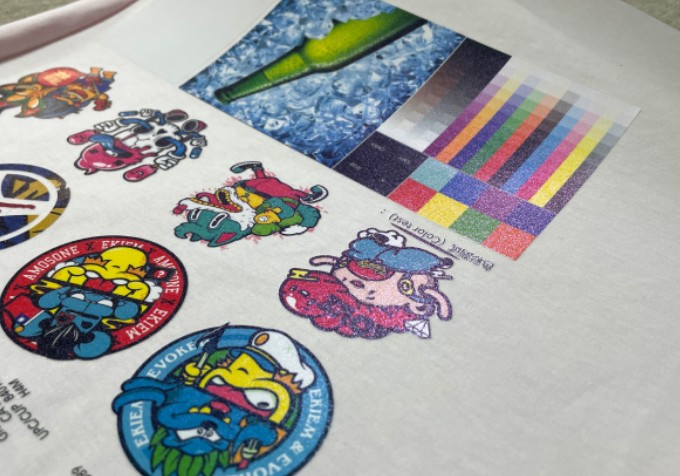28
Jul
Are you a printer who has recently heard of Direct to Film printers or DTF for printers? Yes, digital printing is still a relevant and popular method of printing, but DTF is definitely sweeping the market.

However, since around 2020, a new player has entered the field, sparking interest and challenging the status quo: direct-to-film (DTF) printing. This innovative technology has caused a stir in the industry, introducing a new method of garment printing and potentially reshaping the landscape of printing methods. As we delve further into this exciting frontier, it is clear that the development and diversification of apparel printing technology continues to gain momentum. So let us find out why DTF is stirring the printing sector.However, since around 2020, a new player has entered the field, sparking interest and challenging the status quo: direct-to-film (DTF) printing. This innovative technology has caused a stir in the industry, introducing a new method of garment printing and potentially reshaping the landscape of printing methods. As we delve further into this exciting frontier, it is clear that the development and diversification of apparel printing technology continues to gain momentum. So let us find out why DTF is stirring the printing sector.
What is dtf printing?
DTF is a printing process that transfers designs directly onto garments or other substrates. The transfer is accomplished by transferring the design to a unique transfer film and applying heat to the film and the desired surface.
The DTF process has many advantages over the DTG process:
1.DTF printers and DTG variants come with a white ink circulation. However, DTF printers use white ink circulation with such precision that you will not have to worry about distortion or unwanted white lines.
2. DTF printing provides printouts with vibrant colors and a wide color gamut (results will vary depending on the ink supplier).
Print quality is also said to be excellent, as the inherent surface regularity of PET film allows for the creation of fine print marks, so lines, small fonts and fine details can be printed accurately.
3. DTF printing also enhances the feel of garments because of the lower quality of the solids used and, for the same reason, elasticity and stretch are said to be improved.
DTF Machinery
Initially, DTF printing was very small and affordable, proprietary to standard inkjet printers (desktops) using textile-specific inks, and these printers were readily available from a wide range of manufacturers.
However, with the development of the significant benefits of DTF printing, such as the innovation of no fabric limitations and faster printing, many of the major digital press manufacturers now offer a wide range of machinery to the market, offering variable speeds and entry-level pricing structures. Over time, the technology has evolved to enable the industry to adopt industrial processes.

Recently, Mimaki released the new TXF150-75, which marks their entry into this high-end brand clothing market.
And we, TEXTEK, have developed a powder shaker adapted to the newly launched Mimaki TXF150-75, the powder shaker width is 70 cm, and the length is 80 cm. It will help you save more space and cost.
Procedures Involved in DTF Printing
The process of DTF printing is relatively simple. It works as follows:
Step 1: Print Your Image on Film
Insert the PET film into the printer containers before printing your design or image. Print your image in white first, and then print it in color over the white layer.
Step 2: Apply the Powder
You will now apply the hot-melt material to the printed film. Applying the powder as evenly as possible while the ink is still fresh is essential, and you should shake off any excess powder. You could use an automated powder shaker to ensure this is carried out correctly.
Step 3: Melt the Powder
Once the DTF powder has been applied to the film, it needs to be dissolved. This is usually done by placing the film in a curing oven and heating it for two to three minutes.
Step 4: Pre-Pressing
Make sure your fabric has been pre-pressed with a heat press to get a wrinkle-free, smooth surface ready for your printed transfers. This process also helps to dry the material thoroughly.
Step 5: Transferring Your Image
Even though you can store your DTF film transfer for future use, you can begin transferring your image to the fabric once you have completed the previous four stages. First, place the PET film with the image and powder fused onto the material into the heat press to ensure a strong bond.
Step 6: Peeling
Please wait for the film to cool before removing it from the fabric. You should avoid removing it directly from the heat press as the hot melt powder acts as an adhesive when it cools, ensuring that the ink adheres firmly to the fabric.
Step 7: Final Pressing
This stage is optional, but you should probably perform this stage with washing and rubbing fastness for best results. First, transfer the fabric to the heat press and press for 10 seconds.

Market Trends
1.Customization And Personalization
2.Eco-Friendly Printing Practices
3.Digital Printing Technologies
Customization And Personalization
The demand for customized and personalized products and services has increased in recent years. Consumers are increasingly seeking unique, personalized products to meet their needs and preferences. This trend is particularly evident in the apparel industry, where more and more consumers are looking for customized clothing that they can wear with pride.
DTF transfer printing is perfectly suited to meet this need for customization and personalization. With DTF Transfer Printing, it is now possible to create customized designs for garments quickly, easily and cost-effectively. This is a great option for companies that want to provide consumers with the ability to create custom garments with unique and personalized designs.
Eco-Friendly Printing Practices
The trend towards eco-friendly printing practices is becoming increasingly popular. More and more companies are looking to reduce their environmental impact by using printing techniques that are less harmful to the environment.
DTF transfer printing is a great option for businesses that adopt environmentally friendly printing practices. The process uses fewer chemicals and less energy than traditional printing techniques, making it a more sustainable and responsible printing option. Additionally, DTF transfer printing produces less waste, making it a good choice for businesses looking to reduce their carbon footprint.
Digital Printing Technologies
The growing popularity of digital printing technology is another trend shaping the future of DTF transfer printing. Digital printing technology has revolutionized the printing industry, making it easier and faster to produce high-quality printed materials.
DTF transfer printing is a great option for businesses looking to take advantage of digital printing. The process uses digital transfer paper to produce prints of the same quality as those produced using traditional printing techniques. In addition, DTF transfer printing is extremely cost-effective, making it an attractive option for businesses looking to cut costs.
Conclusion
With the growing demand for customization and personalization, the increasing popularity of eco-friendly printing practices, and the increasing availability of digital printing technology, the future of DTF transfer printing looks exciting. These trends will shape the future of DTF transfer printing, making it an attractive option for companies looking to provide their customers with unique, personalized, and eco-friendly garments.

Future Predictions
The future of digital textile printing is an exciting prospect for companies in the textile industry. From humble beginnings, technology has skyrocketed and many new techniques and materials are now available. As the industry expands and develops, there are many opportunities for companies to capitalize on the growth and expansion of the market.
Digital textile printing is a revolutionary technology that enables companies to produce high quality prints on fabrics in a very short period of time. It is a process that combines inkjet printing technology with digital images or data to create vibrant color prints on a variety of materials. The technology has seen significant growth in recent years and has become a popular choice for apparel, interior design and home decoration.
In terms of future projections, it is likely that the technology will only continue to evolve and expand. As current technology advances, DTF printers are expected to become more efficient and cost-effective. This may further reduce printing times and costs, allowing companies to produce more prints in less time.
Overall, the future of digital textile printing is an exciting prospect for companies. With the potential for new technologies and materials, the industry is likely to continue to grow and expand, allowing companies to capitalize on the market's growth. Companies looking to stay ahead of the competition should invest in research and development to ensure they are up to date with the latest technology.
TEXTEK's business covers many countries around the world, including emerging markets and mature markets. We have a complete sales system and are committed to using our professional knowledge and first-class service to help customers improve their digital printing business.
.jpg)
